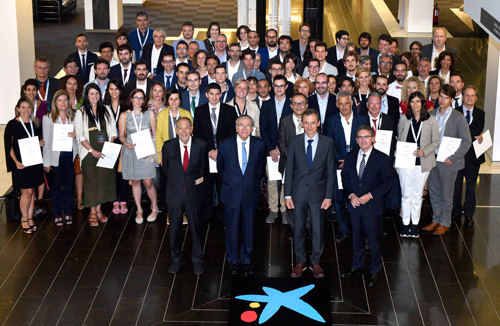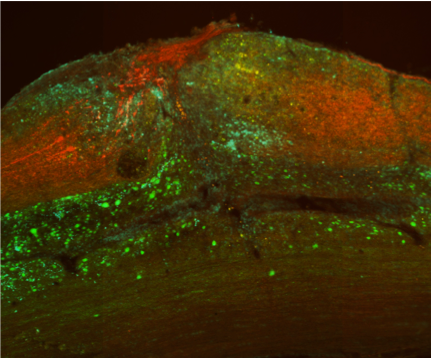Jose Antonio del Rio
Group leader
Tau, a key protein against Alzheimer’s
 José Antonio del Río, group leader at IBEC, has received funding from the “CaixaHealath” call from “la Caixa” to continue advancing in the fight against Alzheimer’s.
José Antonio del Río, group leader at IBEC, has received funding from the “CaixaHealath” call from “la Caixa” to continue advancing in the fight against Alzheimer’s.
Identified a new repairing mechanism of the peripheral nervous system by applyting bioengineering techniques
 The Molecular and cellular neurobiotechnology group with the collaboration of the Nanobioengineering group, both of them at IBEC, have applied a new light-stimulated technique to modulate muscular activity and stimulate cell regeneration of the peripheral nervous system.
The Molecular and cellular neurobiotechnology group with the collaboration of the Nanobioengineering group, both of them at IBEC, have applied a new light-stimulated technique to modulate muscular activity and stimulate cell regeneration of the peripheral nervous system.
Thanks to this research they have discovered that muscle activity can activate the neurons and accelerate their regeneration after an injury.
New advances in the improvement of the design of drugs against glial globular tauopathy
 José Antonio del Río, principal investigator at the Institute for Bioengineering of Catalonia (IBEC) together with Dr. Isidre Ferrer from Bellvitge Biomedical Research Institute (IDIBELL) led a study where they have unraveled that the pathology shown by patients with Globular Glial Tauopathy is due to the generation of harmful protein deposits for neurons and glial cells.
José Antonio del Río, principal investigator at the Institute for Bioengineering of Catalonia (IBEC) together with Dr. Isidre Ferrer from Bellvitge Biomedical Research Institute (IDIBELL) led a study where they have unraveled that the pathology shown by patients with Globular Glial Tauopathy is due to the generation of harmful protein deposits for neurons and glial cells.
Tauopathies are characterized by the accumulation of phosphorylated tau protein, that associates with phosphate groups.
Three researchers from IBEC awarded with grants from “la Caixa” for their pioneering and high social impact research
José Antonio del Río, Pau Gorostiza, and Samuel Sánchez have been awarded in two of the “la Caixa” calls.
José Antonio del Río, principal investigator of the Molecular and Cellular Neurobiotechnology Group at IBEC, is one of the winners of the second edition of the call for applications in biomedicine and health. Del Río’s project focuses on analysing the molecular mechanisms involved in the genesis and propagation of tau protein in brain cells. This protein is linked with several neurodegenerative processes and is present in numerous diseases such as Alzheimer’s.
Pau Gorostiza, principal investigator of the Nanoprobes and Nanoswitches Group, also received an award at the second edition of the call for applications for research projects in biomedicine and health. In this case, for his project on degenerative eye conditions such as retinitis pigmentosa, which causes blindness due to the progressive degeneration of the cones and rods, which are the light sensitive cells.
José Antonio del Río interviewed at “La Marató dels investigadors” TV program
Last sunday 14th July, José Antonio del Río was interviewed at “La marató dels investigadors” TV program to celebrate the closure of cicle of “la Marató 2013” which was dedicated to neurodegenerative diseases, in which his research recieved funding.
A mechanism has been discovered that could improve spinal cord injuries
A study led by researchers from IBEC and Imperial College London has identified a mechanism that regulates the regenerative failure in lesions of the central nervous system. For the first time, experts have also proven how the genetic or pharmacological inhibition of the new therapeutic target could overcome regeneration failure following spinal cord injury
Will I recover from this injury? Answering this question that many patients ask themselves after a fall or any other type of accident or disease is still a major challenge. And the fact is that the molecular mechanisms that discriminate between regeneration success or failure remain a mystery to science. Although lesions of the peripheral nervous system may be partially reversible, lesions of the central nervous system cannot regenerate themselves in the same way. This lack of regenerative capacity is mainly responsible for the functional deficits that appear after a spinal cord injury, for example.
José Antonio del Río presents the results about his research at the 20th Symposium of “La Marató de TV3”
José Antonio del Río, group leader of the Molecular and cellular neurobiotechnology group at IBEC, presented at the 20th Symposium of “La Marató de TV3”, the results of his research on neurodegenerative diseases boosted by the funds of “La Marató” in 2013.
During the event, which took place this weed at the “Institut d’Estudis Catalans”, it has been made public the results of the 79 research teams that have carried out the 44 financed projects by the 2013 edition of this program. A set of achievements targeted to design new tools of prevention and diagnostic, as well as new therapeutic approaches to improve the quality and life expectancy of the patients that suffer a neurodegenerative disease. .
“Cuestionan el uso de antioxidantes para tratar las lesiones medulares”
 Yesterday’s press release about Arnau Hervera and José Antonio del Río’s work, together with Imperial College, that was published in Nature Cell Biology and described their discovery that oxidizing species regulate the regeneration of damaged neurons after spinal cord injuries, was covered in ABC and El Progreso today.
Yesterday’s press release about Arnau Hervera and José Antonio del Río’s work, together with Imperial College, that was published in Nature Cell Biology and described their discovery that oxidizing species regulate the regeneration of damaged neurons after spinal cord injuries, was covered in ABC and El Progreso today.
A mechanism that regulates neurogenesis in the adult brain
 Scientists from IBEC’s Molecular and Cellular Neurobiotechnology group have discovered a protein and its receptor that control the spread of adult stem cells in the hippocampus, the part of the brain responsible for memory.
Scientists from IBEC’s Molecular and Cellular Neurobiotechnology group have discovered a protein and its receptor that control the spread of adult stem cells in the hippocampus, the part of the brain responsible for memory.
The discovery could shed light on the mechanisms involved in memory, the development of neurodegenerative diseases such as Alzheimers, or in the development of brain tumors caused by the uncontrolled proliferation of various cell types.

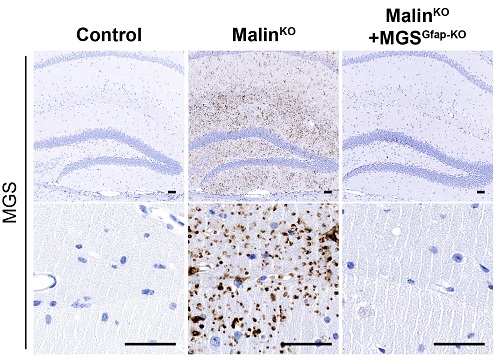

 José Antonio del Río, group leader at IBEC, has received funding from the “CaixaHealath” call from “la Caixa” to continue advancing in the fight against Alzheimer’s.
José Antonio del Río, group leader at IBEC, has received funding from the “CaixaHealath” call from “la Caixa” to continue advancing in the fight against Alzheimer’s.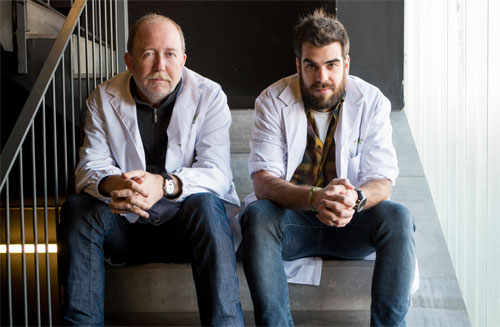
 The Molecular and cellular neurobiotechnology group with the collaboration of the Nanobioengineering group, both of them at IBEC, have applied a new light-stimulated technique to modulate muscular activity and stimulate cell regeneration of the peripheral nervous system.
The Molecular and cellular neurobiotechnology group with the collaboration of the Nanobioengineering group, both of them at IBEC, have applied a new light-stimulated technique to modulate muscular activity and stimulate cell regeneration of the peripheral nervous system.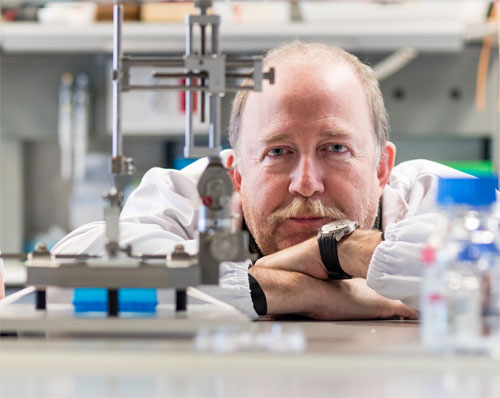
 José Antonio del Río, principal investigator at the Institute for Bioengineering of Catalonia (IBEC) together with Dr. Isidre Ferrer from Bellvitge Biomedical Research Institute (IDIBELL) led a study where they have unraveled that the pathology shown by patients with Globular Glial Tauopathy is due to the generation of harmful protein deposits for neurons and glial cells.
José Antonio del Río, principal investigator at the Institute for Bioengineering of Catalonia (IBEC) together with Dr. Isidre Ferrer from Bellvitge Biomedical Research Institute (IDIBELL) led a study where they have unraveled that the pathology shown by patients with Globular Glial Tauopathy is due to the generation of harmful protein deposits for neurons and glial cells. 